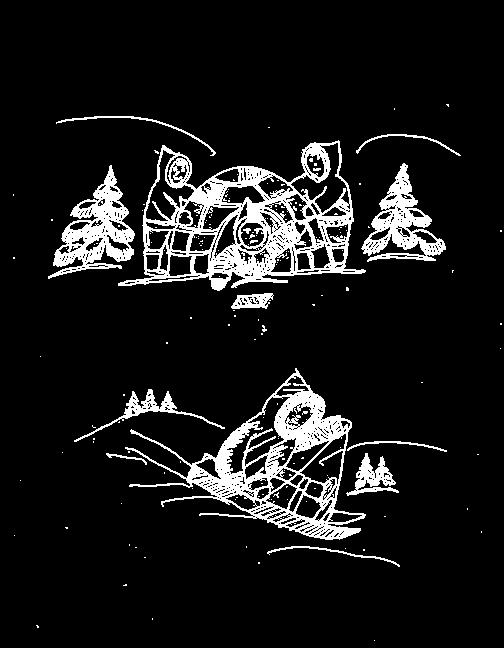
2 minute read
Fishing out to Cut Throat
When it was time for us to go out to Cut Throat, there was a lot to do. Mummy used to have a garden, and we’d make sure the kellup was around the edges to make the vegetables grow.
Kellup: Seaweed.
Reflections from Them Days
And then we’d have to take a motorboat-load of wood out to Cut Throat to have to burn in the summer. And then we’d come back in the summer once to check the place.
At Cut Throat Harbour every family had their own stage. It was families from around everywhere—Okak Bay, Udlik, Nutak. The Merkuratsuks had the biggest stage, and there was one big old stage that would hold salt and stuff.
There’d be a lot of schooners in Cut Throat. You’d get a lot of things brought down in the spring from the schooner people. MacMillan would travel down every summer and bring down second-hand clothes and rubbers and that.
Stage: A shoreline compound of wooden platforms, sheds, and tables where fish are processed.
MacMillan: Admiral Donald MacMillan commanded a schooner called the Bowdoin. His ship would periodically bring supplies to the North Coast of Labrador. In 1929, he donated and transported supplies used to build the Nain Boarding School.
Nellie Winters
Everybody’d be excited back them days. We’d have stuff all made up to trade with, you know. Beautiful carvings and beautiful tablecloths all worked with embroidery, all kinds of stuff. Basket work, everything. A lot of men done nice carvings, sometimes even from wood, like Kamutiks and dogs. And me and my brother Harold used to do pretty good-looking Kamutiks and dogs, just as a pastime in the evenings. The heads on the Kamutik bars had to be made really nice. We used to have a good old time out Cut Throat. Saturday night there’d always be a big dance, till twelve o’clock—had to stop because then it was Sunday. No one would even go out to haul the traps or fish on Sundays. Everything stopped on Sundays.
Reflections from Them Days
We used to go over to Ladybug Island, get all our bakeapples. That’s a beautiful place there, the sand. You go right ashore in the motorboat and not hit nothing, just the pretty sand, jump out. That was the time when the war was still on, around 1944. We didn’t hear much about the war them days, being where we were. One time we was berrypicking, picking blueberries and blackberries up on Cut Throat Hill, a lot of us young ones. And we seen these boats coming, strange boats like we never seen before. Every kind! And some of the kids throwed away their berries and ran, they were running down over the hill to tell our parents we think the war is coming! We thought they was war boats because we never seen those kinds of boats before—we only knowed the old schooners and freight boats, you know. What happened was that those strange boats were travelling to the radar station at Saglek, and there must have been a big sea on, so they were travelling close to shore. Gave us all some fright, we thought we were going to be blowed up!
Nellie Winters
When we’d come back in the fall after fishing all summer, we’d have to start getting ready for the winter. We’d travel around a lot in the motorboat for hunting and stuff. And in the fall when we left Cut Throat we’d always stay in Nutak for a while, us and the Onaliks, get all the bills paid up and do things out there, help to unload the boats that brought freight, help to build stuff that had to be built. We never used to be finished work till nine or ten in the night. We had a radio that worked from windchargers. Same as for the electric lights in Nutak—we didn’t need diesel for radio and lights, the windchargers did it all. We’d listen to the radio some nights. The radio was mostly made of wood, eh. That’s the same radio my parents listened to when we used to call home once a month, when we were in the boarding school in Nain.






